1 Cup Of Sugar Is How Many Grams
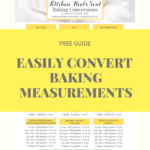
If you lot are looking to convert baking recipes from cups to grams, use the tables of baking conversions below to guide you when converting ingredients like powdered sugar from cups to grams, or flour from cups to grams, or butter from cups to grams. There's a little math involved, but it's worth it. In one case you lot know how to convert a recipe from one unity of measure to some other, yous will exist able to bake nigh anything, regardless of where the recipe was developed or how the ingredients were measured.

In North America, about home bakers are used to using measuring cups to mensurate out ingredients for baking, whether dry ingredients, or wet ingredients. In Europe and other parts of the earth, information technology's more mutual to weigh ingredients and employ a kitchen scale. To convert recipes from weights to volumes, or from metric units to imperial units, you lot will need to get comfortable with all the ways nosotros express and abbreviate volumes. Get the baking conversion charts parcel to assist you convert pans, ingredients, volumes, weights, temperatures, and more!
Jump to:
- Get familiar with the units of measure and their abbreviations
- Kitchen tools you need for measuring ingredients
- Why "how much does 1 loving cup weigh" isn't the correct question to enquire
- Conversions for fats
- Flour
- Sugars
- Chocolate
- Basics
- Oats
- Converting metric volumes (mL) to regal volumes (cups)
- Baking conversions chart
Get familiar with the units of measure and their abbreviations
Some recipe writers will spell out the units of measure in their recipe, as grams and ounces, for example, while others may abbreviate them to thousand and oz. Here'due south a rundown of the commonly used abbreviations for the units of measure used in blistering.
Book units
In baking, volumes are usually expressed with the following units and abbreviations:
- teaspoon is abbreviated to teaspoon or sometimes t
- tablespoon is abbreviated to tablespoon or sometimes T
- cups aren't unremarkably abbreviated just y'all may see them written equally C or c
- millilitre is abbreviated to mL
- litre is abbreviated to L
- fluid ounces are abbreviated to fl oz
Bones baking conversions to remember for volumes
While teaspoons and tablespoons are common in many countries, they aren't common everywhere. Furthermore, ane teaspoon can mean dissimilar volumes, depending on the location, though normally, the conversions for volumes are as follows:
- 2.v mL is ½ tsp
- 5 mL is one tsp
- 15 mL is 1 tbsp
- 60 mL is ¼ cup
- 80 mL is ⅓ cup
- 125 mL is ½ cup
- 180 mL is ¾ cup
- 160 mL is ⅔ cup
- 250 mL is i cup
- 8 fl oz is 250 mL or one loving cup
- 32 fl oz is 1 L
Weight units
Bakers limited weights using the post-obit units and abbreviations:
- ounces are abbreviated to oz
- grams are abbreviated to one thousand
- kilograms are abbreviated to kg
- pounds are abbreviated to lb
Conversions for regal to metric weights
- 1 lb is equivalent to 16 oz or 454 g
- 2-¼ lb is equal to i kg
- thou m is equal to 1 kg
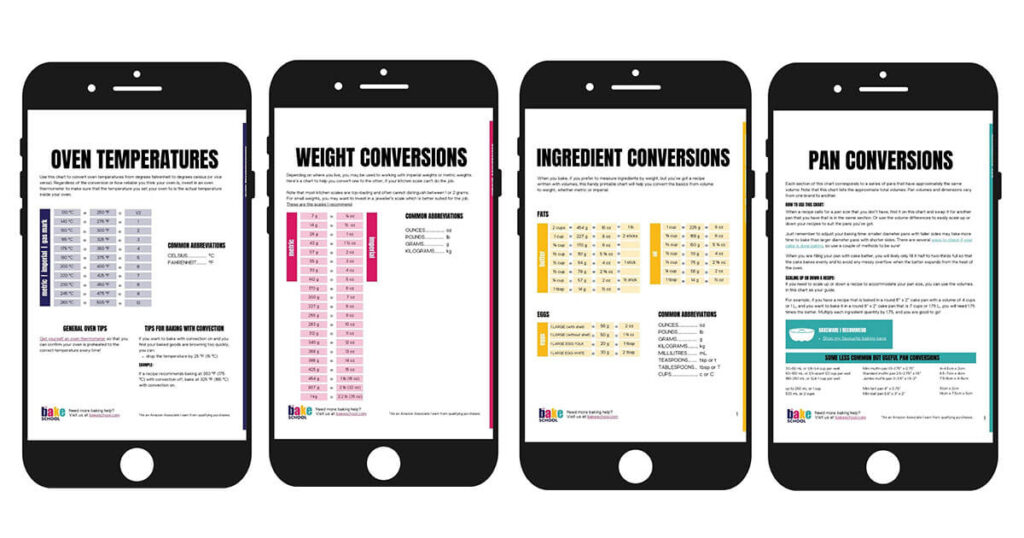
Remember that when you measure dry ingredients, apply cup measures designed for dry ingredients (like these on Amazon), like flour, sugars, oats, etc. On the other hand, use a measuring loving cup designed for liquids (like this one on Amazon) when you demand to measure ingredients similar milk, water, and anything that is fluid!
While both tools mensurate volumes, it's a lot easier to fill dry out measuring cups with dry ingredients and level them past running the back of a knife across. And liquid measuring cups brand filling, pouring, and walking around a lot less messy. No spills! Trust me! For nut butters, I employ dry out measuring cups. Utilise the tool that you are most comfy with.
For small quantities of ingredients, never weigh them unless yous have a scale that can handle minor weights of less than x grams. So for ingredients like baking soda, baking powder, and salt, apply tablespoons and teaspoons, non your kitchen scale.
If you are unsure, consult this guide to measuring baking ingredients and then you use the tools you have properly!
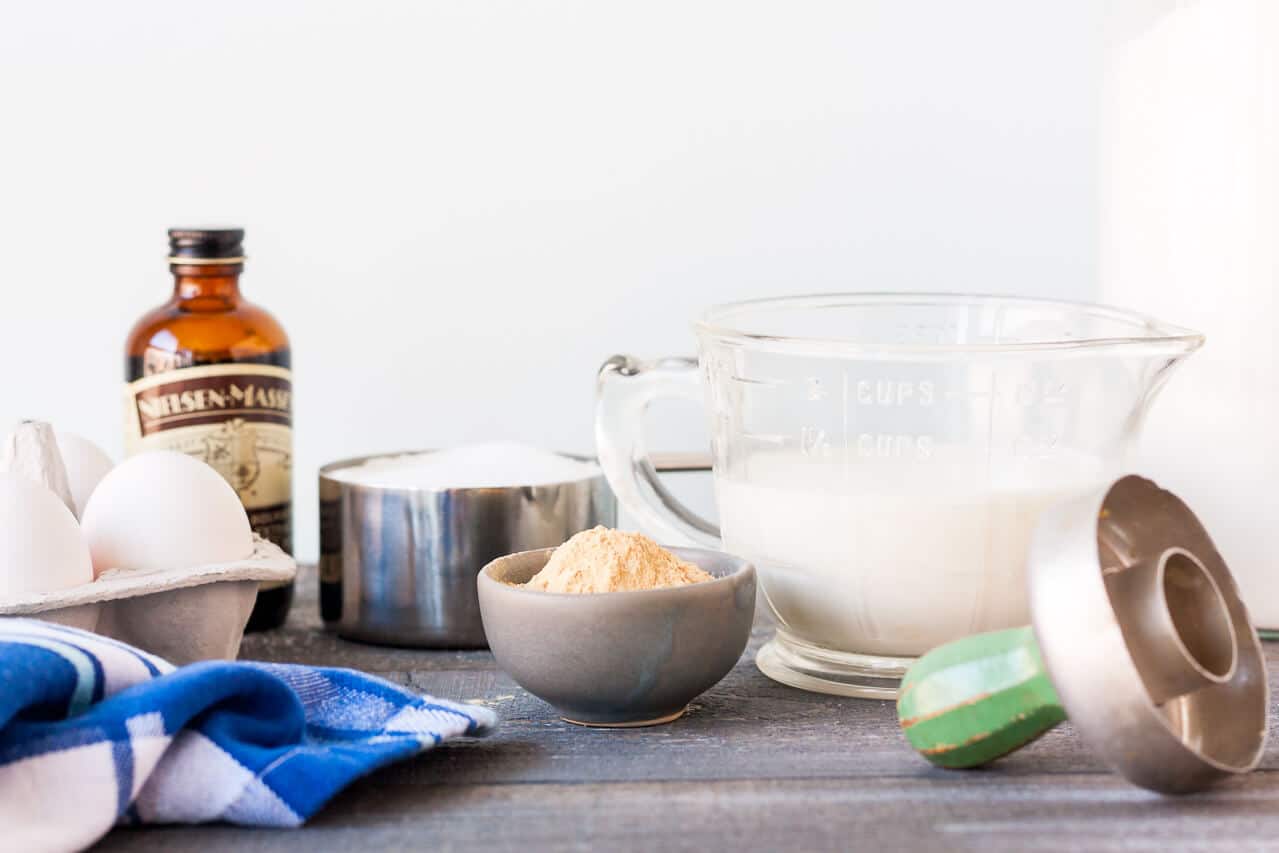
Get the blistering conversion charts
Ane essential tool if you lot want to transition to baking with your kitchen calibration by weight instead of with measuring cups is a baking ingredients conversion nautical chart. I've put together an like shooting fish in a barrel-to-use printable Baking Conversions Chart with all the most common baking ingredients that you will demand to broil virtually recipes, including the ones on this web log. The baking conversions nautical chart includes cups, metric & imperial measurements (grams & ounces), and information technology's printable! Buy the complete parcel of baking conversion charts to catechumen ingredients, pans, temperatures, volumes, weights, and more than.
Here are the tools you need to measure ingredients in your kitchen:
- Dry measuring cups: I like heavy duty stainless steel dry measuring cups that sit down flat on the counter so that I can spoon ingredients into them easily without the risk of them tipping over. I recommend this OXO prepare of dry measuring cups from Amazon, which hold together with a magnet.
- Set of measuring spoons: I own this stainless steel set that you tin find on Amazon. The spoons fit in most jars.
- Liquid measuring cups: I like this set of glass Pyrex measuring cups that you lot can find on Amazon. Ideally, you should have a one cup liquid measuring cup and a ii cup liquid measuring cup. I too have a four loving cup measuring cup, which is more useful for cooking than blistering (similar if yous have to measure large cups of stock or water for soups and stews). Oxo makes a ready of peachy liquid measuring cups that are piece of cake to read from above. If you have trouble angle downwards to read a cup measurer, I highly recommend the Oxo measuring cups! Yous can also observe them on Amazon.
- Kitchen scale: I take tried several brands just I love the Oxo kitchen scale the most. The OXO kitchen scale takes regular AA batteries, information technology can also be used to weigh by deviation (with negative numbers!), information technology has a pull out display, and the stainless steel plate that you weigh on tin can exist removed, making washing so much easier—go the OXO kitchen calibration on Amazon. Past the way, OXO has a new version of their popular kitchen scale on Amazon, but I haven't tried information technology yet.
- Technique is everything so make sure to read this guide to measuring ingredients for baking, so that you lot employ the all-time techniques.
Beneath you lot will detect a list of baking conversions that I follow when I'g baking so yous can easily convert from grams to cups, or the other fashion around. If you take to supervene upon 1 ingredient with another in your recipes, brand sure to consult this list of baking substitutions to guide y'all through the process.
Why "how much does one cup weigh" isn't the right question to inquire
"How much does 1 cup weigh?" is a question that I get asked a lot, just it's a question that is too vague for me to answer without more details: the reality is that the weight of 1 cup of anything is dependant on the density of the ingredient you are measuring. So 1 loving cup of all purpose flour does not weigh the same thing as i cup of chocolate or i loving cup of skim milk, for instance. The volume of 1 cup of flour and i cup of milk is the same. Yes. Merely the weight of 1 cup of these ingredients is non. If you are wondering how to convert from volumes to weights, or vice versa, keep reading or sign up to download this baking conversions chart pdf.
Conversions for fats
Blistering conversions for butter from cups to grams
Every bit a dominion: 1 stick of butter is ½ cup and weighs 115 grams; 2 sticks of butter is 1 cup and weighs 230 grams. A pound of butter is four sticks of butter and weighs 450 grams. You should note that ane stick of butter is also equivalent to 8 tablespoon of butter. Half a stick of butter is equivalent to ¼ cup or iv tablespoon of butter. Don't misfile the big pound block of butter with the smaller baking sticks.
- 1 cup butter weighs 230 grams
- ¾ loving cup butter weighs 173 grams
- ⅔ cup butter weighs 153 grams
- ½ cup butter weighs 115 grams
- ⅓ cup butter weighs 77 grams
- ¼ cup butter weighs 58 grams
Baking conversions for oil from cups to grams
The conversion from volume to weight for oil is slightly dissimilar than butter. Oil has a lower density than butter, therefore 1 loving cup oil weighs a footling less than ane cup of butter. In fact, one loving cup of oil weighs 225 grams.
- 1 cup oil weighs 225 grams
- ¾ cup oil weighs 170 grams
- ⅔ loving cup oil weighs 150 grams
- ½ loving cup oil weighs 113 grams
- ⅓ cup oil weighs 75 grams
- ¼ cup oil weighs 56 grams
Flour
The weight of 1 cup of flour varies according to the type of flour. It also varies greatly co-ordinate to how you fill the measuring cup with flour. I measure flour using the spoon-into-cup method, as opposed to the scooping method.
- For the spoon-into-cup method, you are spooning the flour into the dry measuring cup and i cup of flour is equivalent to 125 grams, on average. You are not packing and compacting the flour into the cup measure. You lot are not borer the measuring cup to pack the flour down and so you tin squeeze in more!
- For the scooping method: if yous have your measuring loving cup and drag it through a bag of flour to make full it, the flour is more compact in the measuring cup and therefore, 1 loving cup of flour will counterbalance 140 grams, if not more.
If you spoon flour into your measuring cup, 1 cup of flour is equivalent to 125 grams, on average. That's the way I fill a measuring cup and and so that is the conversion I use on Kitchen Heals Soul. Hither are some useful conversions of cups to grams of flour.
Baking conversions for all-purpose from cups to grams
As a rule, if yous make full your measuring loving cup by spooning in dry ingredients into the cup, then levelling the superlative, i loving cup of all-purpose flour weighs 125 grams.
- 1 cup all-purpose flour weighs 125 grams
- ¾ cup all-purpose flour weighs 94 grams
- ⅔ cup all-purpose flour weighs 83 grams
- ½ cup all-purpose flour weighs 63 grams
- ⅓ cup all-purpose flour weighs 42 grams
- ¼ cup all-purpose flour weighs 31 grams
- NOTE: The higher up conversions also apply to whole wheat flour, buckwheat flour, bread flour, graham flour, and coconut flour,
Baking conversions for block flour from cups to grams
Cake flour is lighter than all-purpose flour, and so, 1 cup of block flour weighs 115 grams. For chestnut flour, 1 cup weighs 115 grams as well. This conversion besides applies to chopped nuts: 1 cup of chopped basics weighs 115 grams.
- 1 cup cake flour weighs 115 grams
- ¾ cup cake flour weighs 86 grams
- ⅔ cup cake flour nuts weighs 77 grams
- ½ cup cake flour weighs 58 grams
- ⅓ cup block flour weighs 38 grams
- ¼ cup cake flour weighs 29 grams
- NOTE: The higher up conversions also utilise to chestnut flour and chopped nuts
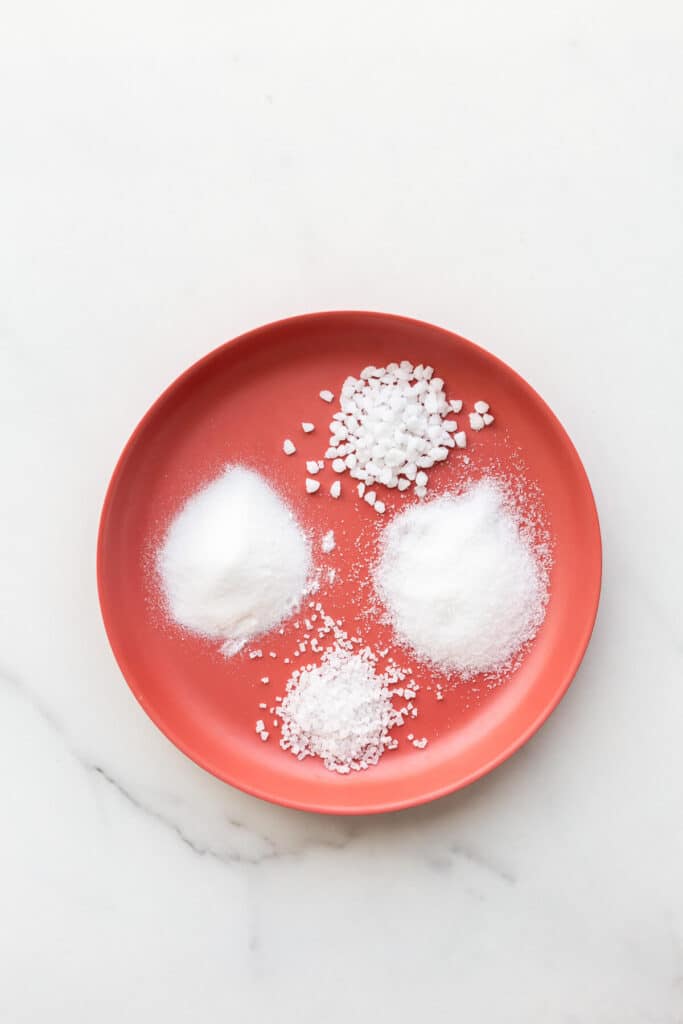
Sugars
Baking conversions for granulated sugar & brown sugar (not packed) from cups to grams
Please note that I do not pack my brown sugar into the cup measurer. I spoon the sugar into the measurer. Equally a rule, i cup of sugar weighs 200 grams. If you are measuring brown saccharide and you pack the brown sugar tightly into the cup measure, ane cup of brownish saccharide volition counterbalance 220 grams, if not more.
- i cup granulated or dark-brown sugar weighs 200 grams
- ¾ cup granulated or brownish saccharide weighs 150 grams
- ⅔ loving cup granulated or brown carbohydrate weighs 133 grams
- ½ loving cup granulated or brownish sugar weighs 100 grams
- ⅓ cup granulated or brown sugar weighs 67 grams
- ¼ cup granulated or brown sugar weighs 50 grams
Remember 1 cup of packed brown sugar weighs 220 grams.
Blistering conversions for icing sugar from cups to grams
I measure out icing sugar (also known equally powdered carbohydrate) the same way I measure flour, using the spoon-into-cup method, as opposed to the scoop-into-cup method. This means that you are not packing and compacting sugar into the cup measure. Others may measure icing sugar differently, but this is how I measure out mine. Generally, 1 cup of icing carbohydrate weighs 125 grams.
- 1 cup icing saccharide or powdered sugar weighs 125 grams
- ¾ cup icing saccharide or powdered carbohydrate weighs 94 grams
- ⅔ cup icing sugar or powdered carbohydrate weighs 83 grams
- ½ cup icing sugar or powdered carbohydrate weighs 63 grams
- ⅓ loving cup icing sugar or powdered sugar weighs 42 grams
- ¼ loving cup icing sugar or powdered sugar weighs 31 grams
Baking conversions for dear and maple syrup from cups to grams
Beloved and maple syrup are quite dumbo and therefore 1 loving cup of honey or maple syrup usually weighs 340 grams (12 oz).
- 1 cup dear or i cup maple syrup weighs 340 grams
- ¾ cup dear or ¾ cup maple syrup weighs 255 grams
- ⅔ loving cup dearest or ⅔ loving cup maple syrup weighs 227 grams
- ½ cup dear or ½ cup maple syrup weighs 170 grams
- ⅓ cup honey or ⅓ cup maple syrup weighs 113 grams
- ¼ cup honey or ¼ cup maple syrup weighs 85 grams
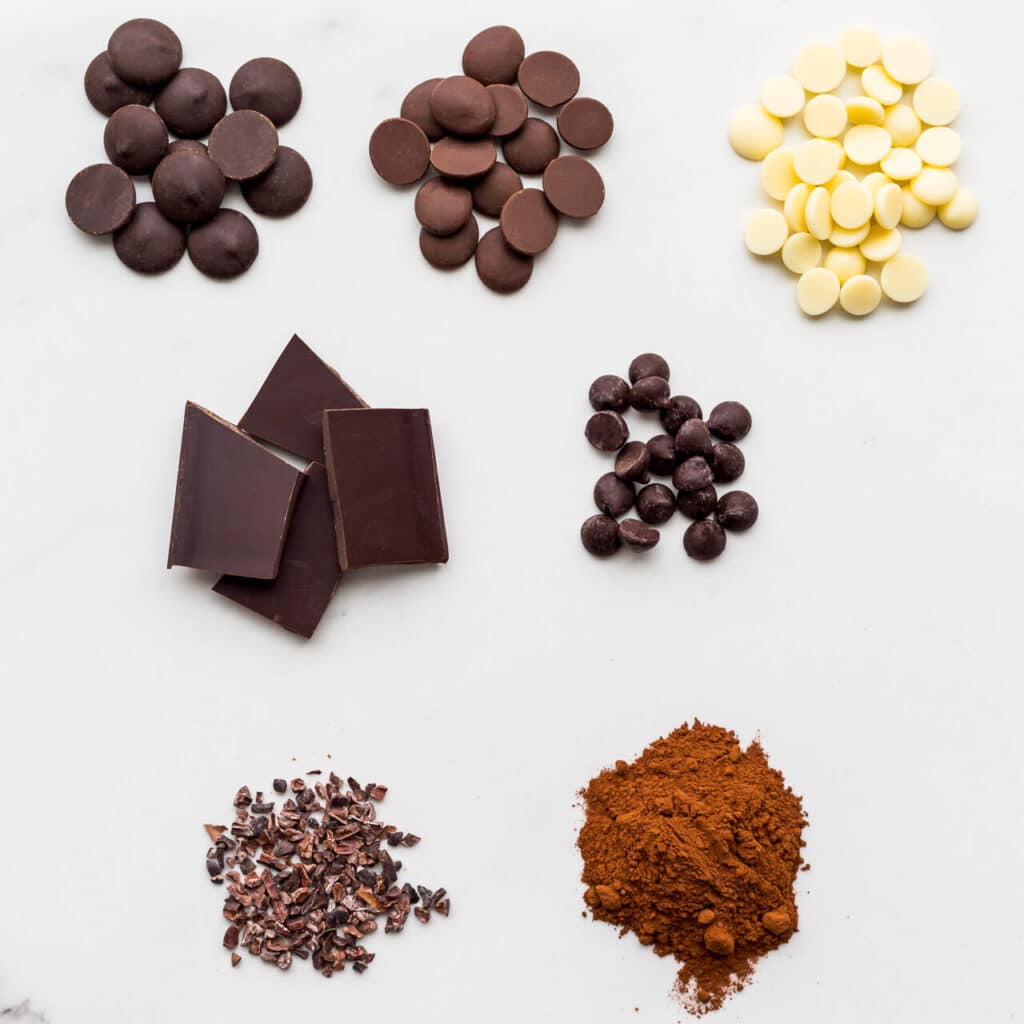
Chocolate
Baking conversions for cocoa pulverization from cups to grams
I measure cocoa the same way I mensurate flour, using the spoon-into-cup method, equally opposed to the scoop-into-cup method. This means that yous are non packing and compacting cocoa into the cup measure. Others may measure cocoa pulverization differently, merely this is how I measure mine. In this manner, ane cup of cocoa powder weighs 100 grams.
- i loving cup cocoa powder weighs ninety grams
- ¾ cup cocoa powder weighs 68 grams
- ⅔ loving cup cocoa powder weighs 60 grams
- ½ cup cocoa powder weighs 45 grams
- ⅓ cup cocoa powder weighs thirty grams
- ¼ cup cocoa powder weighs 23 grams
If you have a recipe with cocoa pulverisation, but only have dark chocolate on hand, check out my guide to how to supercede cocoa powder with dark chocolate.
Baking conversions for chocolate pistoles (specifically Cacao Barry brand) and chopped chocolate from cups to grams
The weight of chocolate per loving cup is entirely dependent on the shape and size of the pieces of chocolate. In general, 1 cup of chocolate weighs 175 grams. This plain varies depending on if yous have big chunks of chocolate or smaller chocolate chips.
- i loving cup chocolate pistoles weighs 175 grams
- ¾ cup chocolate pistoles weighs 131 grams
- ⅔ loving cup chocolate pistoles weighs 117 grams
- ½ loving cup chocolate pistoles weighs 88 grams
- ⅓ loving cup chocolate pistoles weighs 58 grams
- ¼ cup chocolate pistoles weighs 44 grams
Nuts
While ane cup of whole almonds weighs 140 grams and may vary depending on the type of nut you are weighing, 1 cup of chopped nuts weighs 115 grams, and i cup of ground nuts usually weighs 120 grams. For nut butters, generally 1 loving cup of nut butter weighs 255 grams.
Baking conversions for whole nuts (varies according to the nut measured) from cups to grams
- ane cup of whole nuts weighs 140 grams
- ¾ cup of whole nuts weighs 105 grams
- ⅔ cup of whole nuts weighs 93 grams
- ½ cup of whole nuts weighs 70 grams
- ⅓ cup of whole nuts weighs 47 grams
- ¼ cup of whole basics weighs 35 grams
Baking conversions for chopped nuts from cups to grams
- 1 cup of chopped nuts weighs 115 grams
- ¾ loving cup of chopped nuts weighs 87 grams
- ⅔ loving cup of chopped nuts weighs 77 grams
- ½ cup of chopped nuts weighs 58 grams
- ⅓ cup of chopped basics weighs 38 grams
- ¼ cup of chopped basics weighs 29 grams
Baking conversions for footing nuts from cups to grams
- 1 cup of footing basics weighs 120 grams
- ¾ cup of ground nuts weighs 90 grams
- ⅔ loving cup of footing basics weighs 80 grams
- ½ cup of ground nuts weighs 60 grams
- ⅓ loving cup of footing nuts weighs twoscore grams
- ¼ loving cup of ground nuts weighs xxx grams
Baking conversions for nut butters (like peanut butter, almond butter, tahini, etc.) from cups to grams
- one loving cup of nut butter weighs 250 grams
- ¾ cup of nut butter weighs 188 grams
- ⅔ cup of nut butter weighs 167 grams
- ½ loving cup of nut butter weighs 125 grams
- ⅓ cup of nut butters weighs 83 grams
- ¼ cup of nut butter weighs 63 grams
Oats
For rolled oats or large scrap oats, as a rule, 1 loving cup of oats weighs 80 grams. If the measuring cup is packed tightly, 1 cup of oats could weigh 100 grams.
Baking conversions for rolled oats from cups to grams
- Convert rolled oats from cups to grams
- 1 cup of rolled oats weighs 90 grams
- ¾ cup of rolled oats weighs 60 grams
- ⅔ cup of rolled oats weighs fifty grams
- ½ cup of rolled oats weighs 40 grams
- ⅓ loving cup of rolled oats weighs 25 grams
- ¼ loving cup of rolled oats weighs twenty grams
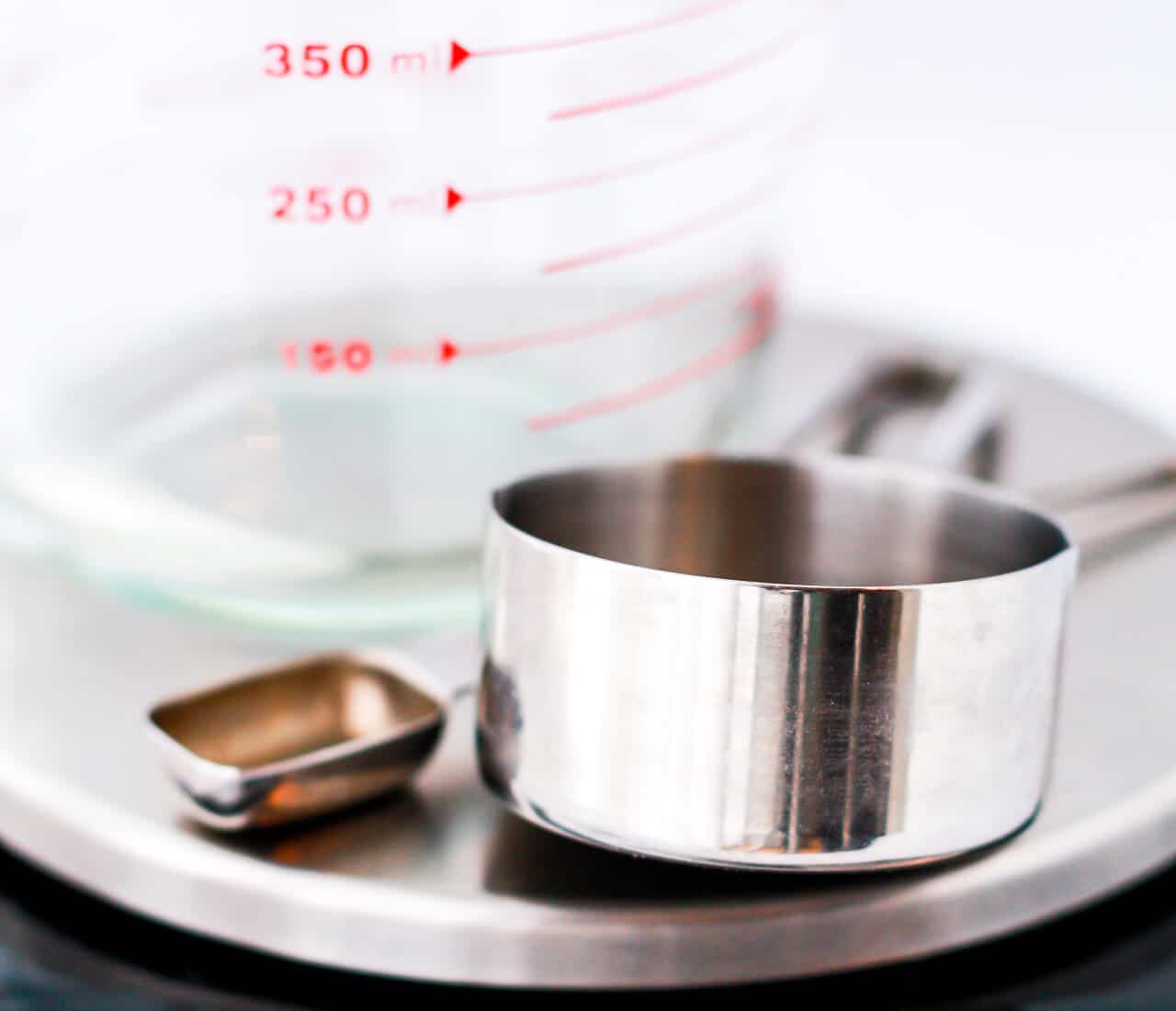
Converting metric volumes (mL) to imperial volumes (cups)
Some websites set up 1 loving cup every bit 236 mL (or 240 mL). Others prepare ane cup every bit 230 mL. Personally, I set 1 cup to 250 mL. The important matter is to be consequent. I'm honestly not sure any measuring cups are truly able to distinguish between 240 mL and 250 mL, so let's telephone call one loving cup 250 mL and stick with that. Also, I use American tablespoons and teaspoons to measure smaller amounts of ingredients. And i tablespoon (15 mL) is equivalent to 3 teaspoon (3 x 5 mL).
- Conversions for US cups to millilitres
- 1 cup = 250 mL
- ¾ cup = 190 mL
- ⅔ cup = 170 mL
- ½ cup = 125 mL
- ⅓ loving cup = eighty mL
- ¼ loving cup = threescore mL
- Conversions for US tablespoons & teaspoons to millilitres
- ane tablespoon = 15 mL
- one teaspoon = five mL
- ¾ teaspoon = iii.75 mL (rounded to 4 mL)
- ½ teaspoon = 2.5 mL (rounded to 3 mL)
- ¼ teaspoon = 1.25 mL (rounded to 1 mL)
- ⅛ teaspoon = 0.625 mL (rounded to <1 mL)
Delight don't utilise the mL button on your kitchen scale, if it has one, to measure a volume. Yeah, you can weigh a book, but the button on your kitchen calibration is assuming that you are weighing out water, which has a density of 1 gram per millilitre. For example, most oils take a density of 0.nine g per mL, so if y'all employ the mL button on your kitchen scale to measure a volume, it will do then incorrectly and this may lead to problems in your recipe. If you need to mensurate a volume, apply liquid measuring cups (similar this set on Amazon).
Baking conversions chart
I created a handy chart that you lot can download to relieve on your tablet for when you bake. You can also print information technology and keep in your kitchen! The chart volition help you hands convert recipes from volumes to weights, cups to grams, and also convert other baking elements, like fluid ounces to millilitres, temperatures from Celsius to Fahrenheit, centimetres to inches, etc. I'yard giving away the charts FREE if y'all subscribe. Click here to get the details most the baking conversions chart pdf! Yous tin besides buy the complete bundle to convert ingredients, pans, temperatures, volumes, weights, and more than.

If you ever have problem with baking terminology, I've also written out a list of baking vocabulary and French pastry terms that you might discover useful. There'southward likewise take a complete listing of baking abbreviations in instance you need information technology.
1 Cup Of Sugar Is How Many Grams,
Source: https://bakeschool.com/baking-conversions/
Posted by: wertzbarl1988.blogspot.com


0 Response to "1 Cup Of Sugar Is How Many Grams"
Post a Comment